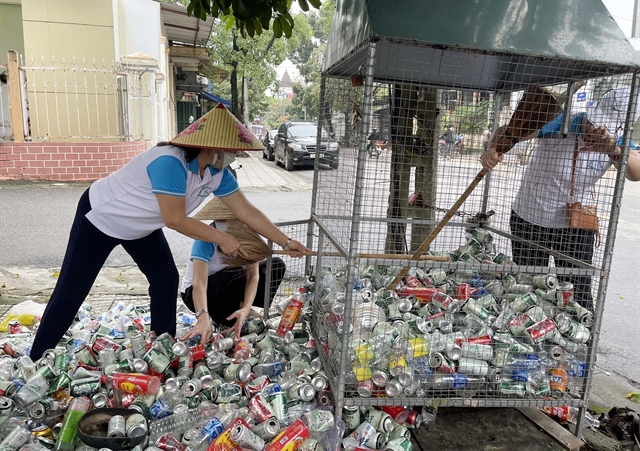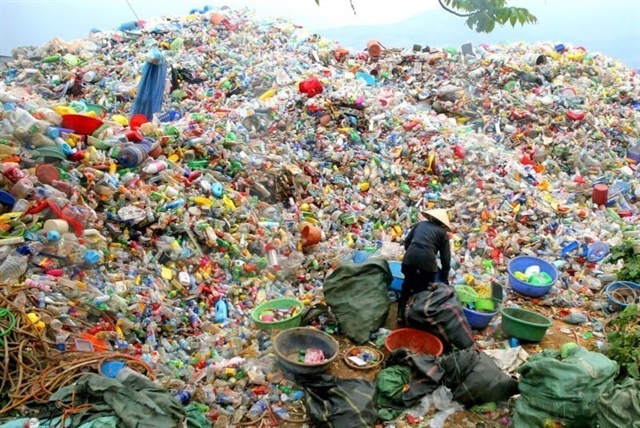 Environment
Environment

 |
| Women in Đông Hà City, Quảng Trị central province collect waste for recycle. — VNA/VNS Photo Thanh Thủy |
HÀ NỘI — On average, Việt Nam discards more than 1.8 million tonnes of plastic waste every year, with less than a third of it recycled.
The rest is buried or burned, polluting the land, air and water.
The majority of the waste we throw away are plastic bags, food polystyrene containers and plastic cups.
It is estimated that, on average, each household uses about 1kg of plastic bags per month, and more than 80 per cent of them are discarded after being used just once.
Although there has been education to change awareness about recycling, most people still maintain the habit of using disposable plastic products in their daily lives.
Plastic bags are everywhere in life, from urban to rural areas and from high-end to low-end consumption areas.
For just a loaf of freshly baked bread priced at VNĐ6,000 (US$0.2), sellers still use a large plastic bag to pack the bread for customers.
Lâm Thanh Tùng, an employee of the Như Liên Bakery on Xô Viết Nghệ Tĩnh Street, Ward 19, Bình Thạnh District in HCM City, said: "Whether it's one loaf or a dozen, we have to put it in a bag properly for our customers.”
Because of the convenience of plastic bags, many consumers use them indiscriminately, regardless of the consequences to the environment.
In traditional markets, plastic bags are widely used, even for items that cost only a few thousand đồng, and sellers often give them away for free.
In the food and beverage business, most take-away foods and drinks are packaged in polystyrene boxes, plastic cups and plastic bags for easy transportation.
Only a few stores use paper bags, paper boxes, paper cups and organic straws.
Hồ Thanh Thủy, owner of the Greenseed's coffee shop on Nguyễn Thị Minh Khai Street in District 3, HCM City, said that in the past, the shop also served paper cups and straws made of rice and reed grass, but now they no longer do.
"Paper cups or rice straws are fine to use on the spot for a while, but if customers sit for a long time or buy them to take away, it is not convenient because the appearance will no longer be beautiful," Thủy said.
Alternative materials for plastic still have higher production costs than plastic bags and disposable plastic items, so are not widely used, making it difficult to limit plastic waste.
Plastic pollution
Plastic pollution has become one of the biggest challenges to sustainable development.
The first consequence of millions of tonnes of plastic waste is clogging drainage systems, polluting soil and water sources, especially causing flooding in large cities.
According to statistics, Hà Nội and HCM City alone discharge an average of 80 tonnes of plastic waste and plastic bags into the environment every day.
Many rivers, canals, ditches and drainage systems of the two cities are full of waste day and night.
Phan Lệ Huyền, who lives next to the Nhiêu Lộc-Thị Nghè canal in Tân Bình District, HCM City, said that although this canal has been revived for more than ten years, it is still often surrounded by waste, not only water hyacinth and dead fish but also a lot of household waste.
After each heavy rain, the green canal is flooded with garbage.
Famous tourist destinations are also affected by plastic pollution.
‘Pearl islands’ such as Phú Quốc in Kiên Giang Province, Phú Quý in Bình Thuận Province, Côn Đảo in Bà Rịa-Vũng Tàu Province, face great challenges of waste treatment, in which plastic waste accounts for the majority.
In recent times, island districts authorities have implemented many solutions to limit waste, especially plastic waste in tourism activities, such as telling boat owners, tourists not to bring plastic bottles, nylon bags, polystyrene boxes and disposable plastic products to the island; calling for small traders and business households on the island to reduce plastic waste, replacing it with environmentally friendly products.
But, with the increasing number of tourists and the amount of waste, dealing with such pollution is still a big challenge, beyond the reach of these localities.
Đặng Minh Hải, a tourist from Hải Phòng, said that he had visited Phú Quốc, Hòn Sơn, and Nam Du in Kiên Giang Province.
She said that although they are all beautiful islands with pristine nature, people and tourists throw rubbish carelessly.
Hải said: "A tourist destination not only attracts visitors by its landscape but also by its clean and beautiful environment. If not handled thoroughly, the litter will affect the ecosystem and natural landscape, especially the marine environment of these pearl islands.”
Solutions
 |
| A rubbish dump with a large amount of plastic waste in Lào Cai northern mountainous province. — VNA/VNS Photo Ngọc Hà |
According to experts, on the positive side, plastic products play an important role in many areas of life and society such as food processing, instant food, medicine and epidemic prevention, helping to ensure hygiene, appearance, preservation, transportation of products, and limit infection.
Therefore, plastic products and disposable plastic packaging are not the main culprits causing pollution.
The threat comes from people's awareness and behaviour towards plastic products.
'Fighting plastic pollution' is the theme of the Environmental Action Month this year.
According to the Ministry of Agriculture and Environment, 'Fighting plastic pollution' is not only a call but also an urgent global warning, requiring the community to take more drastic action.
The role and responsibility of each citizen, household, agency, business, consumer and tourist is increasingly important in changing behaviour towards plastic products and plastic waste.
According to the Law on Environmental Protection, from this year, people have to pay for household waste collection based on weight or volume.
HCM City officially applied a new unified price for waste collection and transportation services from the beginning of this month.
This method is considered not only transparent and fair but also promotes waste classification at its source.
The Việt Nam Tourism Association has been calling for plastic-waste-free tourism.
Côn Đảo is one of the localities participating in the Plastic Reducing Cities Network - a global initiative of the World Wildlife Fund (WWF) - towards zero plastic waste in nature.
Trần Thanh Huyền, Chairman of the Côn Đảo District People's Committee, said that the district aims to end this year, it will no longer use single-use plastic and nylon; gradually switch to alternative products, as well as improve the quality of environmental protection and waste treatment in the area. By 2030, it will be a plastic-waste-free destination.
As a young person, Miss Eco International 2023, Nguyễn Thanh Hà, said she was very concerned when she saw plastic pollution leaving serious consequences for the living environment.
From beaches covered with plastic bags to forests, rivers, and even in the digestive systems of animals, plastic waste is present.
Hà said: "Let's start with the smallest things. Each cloth bag instead of a plastic bag, each personal cup instead of a plastic cup, each refusal of single-use plastic products is an act of love for the earth.
"Don't think that you alone cannot change the world. Instead, think: if you don't start, who will?" — VNS




